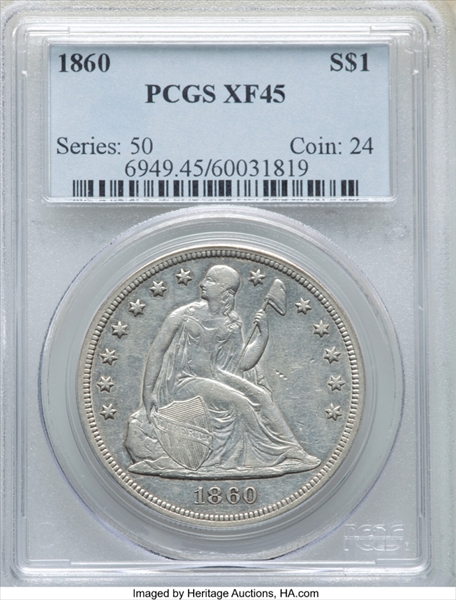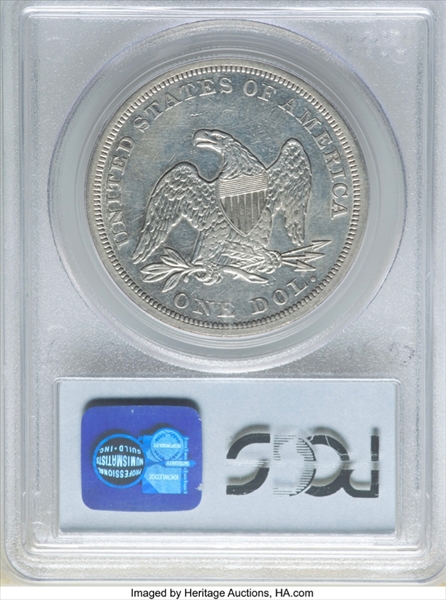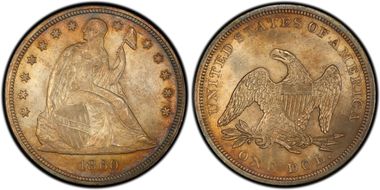1860 $1 XF45 认证号60031819, PCGS号6949
专家评论
Q. David Bowers
The following narrative, with minor editing, is from my "Silver Dollars & Trade Dollars of the United States: A Complete Encyclopedia" (Wolfeboro, NH: Bowers and Merena Galleries, Inc., 1993).Coinage Context
Another export issue: Like its immediate predecessors, Liberty Seated dollars dated 1860 are believed to have been intended primarily for use in the export trade to China. (As Jim Loyd has pointed out (letter to the author, March 22, 1992), if indeed the coinage was intended for shipment to China, it would have been more economical to have shipped Nevada-mined silver to San Francisco for coinage. Of course, New York and other Eastern ports had trade with China, too.) They never were available from the Mint at face value, and all were paid out at $1.08 each to bullion dealers, banks, and others who fed them into the Orient trade. A small percentage of the mintage circulated domestically after the resumption of specie payments in autumn 1876, the results of the acts of January 14, 1875 and April 17, 1876.
Numismatic Information
Circulated grades: Despite a relatively high circulation strike mintage, worn examples are few and far between on the market today. This date seems to be slightly more available than the 1859, but opinions differ. Writing in 1982, Donald Vettel stated that in EF grade 1860 dollars were the scarcer of the two. ("Some Thoughts on Liberty Seated Dollars: A Scarcity and Price Analysis." The Gobrecht Journal, July 1982.)
Mint State grades: The 1860 is likewise very scarce in Mint State. When seen, examples often have a partially prooflike surface. The mint frost on typical specimens is apt to be satiny rather than deeply coruscating and frosty.
Circulation strikes ignored: There was virtually no collector interest in circulation strike Liberty Seated dollars of any kind during this era. Numismatists desiring date sequences of dollars (mintmarks were completely ignored) were satisfied with Philadelphia Mint Proofs, which probably accounted for the placing of fewer than a dozen Proofs in cabinets each year during the decade of the 1840s, and increasing numbers after that, reaching a production of several hundred pieces by 1859. Still, despite mintages which sometimes met or broke the 1,000 mark, Proof dollars were not popular, and many coins were spent once the novelty of owning them passed. The number of unimpaired Proofs surviving from the total mintage of the 1860s is undoubtedly on the order of 50% to 60%, some of the reduction being attributed to coins never released and subsequently melted, and the rest to attrition: spending, cleaning, friction from other coins, improper storage, etc.
Proofs: By 1860 the Mint issue price for a copper and silver Proof set climbed from $2.02 (for $1.94 face value of coins) to $3, for a set which contained a copper-nickel Indian cent, silver three-cent piece, half dime, dime, quarter dollar, half dollar, and silver dollar, again $1.94 face value. This premium of $1.06 represented a charge of 55% over face value for each coin. Proof dollars were sold for $1.60 each in 1860 (and also in 1861; not in later years). (Per letter from R.W. Julian to the author, March 20, 1992.)
By July 1, 1867 the $3 charge for a set was still in effect, (Per "Circular letter in Relation to American Medals and Cabinet Coins, July 1,1867," quoted by Breen, p. 28.) although by this time several new denominations had been added, namely the bronze two-cent piece, and the nickel alloy three-cent and five-cent pieces. On a pro-rata basis, a Proof 1860 dollar would have cost about $1.50, but it was customary to charge proportionally more for smaller denominations. Perhaps on its own a Proof 1860 dollar should have been priced in the $1.25 range but, as noted, the price was just $1.08.
Proof production of the 1860 dollar was abnormally large: 1,330 pieces, the highest Proof figure in the entire Liberty Seated series, all delivered on March 8th. Only 527 were eventually sold, and the rest were consigned to the melting pot. R.W. Julian has written the following on the subject: ("Philadelphia Coinage Statistics: 1853-1873." Numismatic Scrapbook Magazine, August 1964.)
The 1860 Proof coinage of dollars is not the same as the coinage of the other denominations heretofore printed for 1860. The extra 330 pieces coined were produced because the Mint felt that there would be an extra demand for these over the other silver Proofs; this points out that in addition to Proofs being sold in sets, single pieces were sold very frequently, For example, in April 1860, there were 69 full silver sets sold (presumably including a copper-nickel cent in each set) plus 10 silver dollars, 3 half dollars, 16 dimes, 14 half dimes, 16 trimes and 10 cents. It would appear that the Mint officials were wrong in believing that a large number of dollars would be sold beyond the regular set sales because after 1860 all silver coins were made in the same amounts for Proof sets.
Varieties
Circulation strikes:
1. Normal Date: Breen-5463. Circulation strikes are all of one general type, although minor varieties in date positions occur. Some Mint State pieces survive, some of which are prooflike and can be confused with Proofs. On the reverse of some high grade coins there is unfinished die surface in the lower right half of the shield interior.
Dies prepared: Obverse: Unknown; Reverse: Unknown
Circulation strike mintage: 217,600; Delivery figures by day: March 3: 14,000; March 13: 12,000; March 14: 14,000; March 19: 12,000; March 26: 15,000; March 27: 5,000; March 30: 13,000; May 11: 20,000; May 25: 12,200;June 18: 14,000; September 27: 23,000; September 28: 13,000; October 26: 17,000; October 31: 4,000; November 5: 8,000; November 8: 5,000; November 19: 1,000; December 27: 15,400.
Estimated quantity melted: Unknown
Characteristics of striking: Usually well struck. Many higher grade coins show prooflike surfaces.
Known hoards of Mint State coins: None
Commentary
Despite a large mintage, circulation strikes are rare; many were sent to China, where they were melted.
Additional Information
Snowden Describes the Minting Process
The following is from A Description of Ancient and Modern Coins in the Cabinet Collection at the Mint of the United States, by Mint Director James Ross Snowden, 1860, and describes the process of minting coins:
"The system of the present day, although much more multifarious in its details than the ancient process, requires no such army of employees; the whole force employed in the United States Mint, including officers, does not exceed 170.
"Bullion is brought to the mint in every form; amalgamations from the ore, coins, both foreign and domestic, bars, plate jewelry, etc., and these present many grades of quality, some being nearly pure; the remainder representing all the grades of fineness from that down to three thousandths. Some of it is perfectly ductile and easily worked, while a portion is brittle and requires to be toughened. A deposit of gold is often found to contain a large portion of silver which requires to be separated by chemical agents; all these facts are ascertained by the investigations of the Assay Department.
"The process is as follows: The deposit, upon being received, is weighed by the proper officers, and then sent to the deposit melting room, where the deposit is melted in a mass and cast into a bar; this bar is numbered, and a slip cut from it and sent to the assay department: here, by assaying this slip, the amount of pure metal contained in the entire deposit is ascertained. To do this with exactness requires a very careful and accurate manipulation. The operations of this department are intricate, and as they require an extended description for which we have not sufficient space, we are compelled to omit it and return again to the deposit. Its value having been ascertained by the assay, it is ready for the refining process.
"This is not strictly a Mint operation; in some countries these preliminary processes have to be performed by private refiners. But at the Mint of the United States, departments have been provided in which the silver is separated from the gold, the refining and standardizing of the metals, and casting them into ingots or small bars from which the coins are to be made, are performed. The bars or ingots thus produced are about 12 inches long, half an inch thick, and from one to two-and-a-half inches in width, according to the size of the coin for which they are intended. These bars, before being wrought, have to be assayed, in order to test their fineness, and those which are found to be either above or below the legal limits in fineness are returned to the melting room to be remelted and cast at the proper rate.
"The ingots, having been approved, are first brought to a red heat in order to anneal and render them sufficiently ductile to be rolled with facility; they are then passed between hardened steel rollers, driven by a steam engine, which are so .. _ .. arranged that they can be adjusted with the greatest nicety in order to reduce the bar very nearly to the exact thickness required for the coin. In this form they are taken to the drawing bench, driven by the same engine, in which the strip is drawn slowly through the drawing dies, or plates of the hardest steel accurately adjusted to reduce the strips to their proper thickness. The strip, thus prepared, is next passed through the cutting press, also moved by steam, and pieces or planchets of the proper size are cut from it. The punch moves with such rapidity that 160 pieces on an average are cut out in one minute.
At the completion of this part of the process, which leaves the strip full of holes, it is folded up and returned to the melting pot. "The planchets are now carried to the coining room, where, in order to raise the edge of the planchet to protect the surface of the coin, they are passed through the milling machine. The planchets are fed to this machine through an upright tube, and as they descend from the lower aperture, they are caught upon the edge of a revolving wheel and carried about a quarter of a revolution, during which the edge is compressed and forced upon-the space between the wheel and the rim being a little less than the diameter of the planchet. This apparatus moves so nimbly, that 560 half dimes can be milled in a minute; but for large pieces the average is about 120.
"The planchets are next to be cleaned, annealed, and whitened; after which, in the case of the gold, they are adjusted in their weight, piece by piece. (Note: At the French mint this is done by the aid of an ingenious machine of French invention, a sample of which now stands in the Cabinet of the United States Mint. At our mint this is done entirely by hand.) The silver pieces, however, having been tested by samples from each strip, are allowed to pass until after coinage, when their weight is proved in bulk.
"The planchets are now ready to receive the last impression which is to render them a perfect coin. This most important office is performed by the coining press, which we have before mentioned. This machine receives the planchets in a tube from the hand of a workman; as the coin reaches the bottom of the tube it is seized between a pair of fingers and carried forward and deposited within a steel collar between the dies; and while the fingers are expanding and returning for another planchet, the dies close upon the one within the collar, and by a rotary motion are made to impress it silently but powerfully. The fingers, as they again close upon a planchet at the mouth of the tube, also seize the coin, and while conveying a second planchet on to the die, carry the coin off, dropping it into a box provided for the purpose-and this operation is repeated ad infinitum. These coining-presses are of various sizes to suit the different denominations of coins. The usual speed of striking is 60 pieces per minute for the half dollar; 75 for the quarter dollar; and 90 for the dime and half dime.
"The coining dies, it will be necessary to state, are prepared by engravers specially maintained at the Mint for the purpose. The process of engraving a die consists in cutting the devices and legends in soft steel, those parts being depressed which in the coin appear in relief. This having been finished and hardened, constitutes an 'original die;' which being the result of a tedious and difficult task is deemed too precious to be directly employed in striking coins, but is used for multiplying dies. It is first used to impress another piece of soft steel, which then presents the appearance of a coin, and is called a hub. This hub being hardened, is used to impress other pieces of steel in like manner, which being exactly like the original die, are hardened and used for striking the coins. A pair of these will, on an average, perform two weeks' work."
Silver to China
The Bankers' Magazine, August 1860, pp. 126-129, gave the following information:
Imports from China and Singapore into the United States consisted mainly of tea and silk. During the year from April 1, 1859 to March 31, 1860, 47 ships left New York for China, and seven left Boston, a total of 54, as compared to 34 during the preceding period.
It cost about $5 to $10 per ton to ship tea and miscellaneous articles from China to the Eastern ports of the United States, and $15 to $20 for silk goods.
On a fiscal year basis, April 1 through March 31st, the following trade was done with China, in each instance showing a large surplus of imports (primarily paid for in silver) over exports. During the year 1850-1851 $2.5 million value of goods was exported and $ 7.1 million was imported. 1851-1852 exports totaled $2.7 million, imports $10.6 million; 1852-1853 exports $3.7 million, imports $10.6 million; 1853-1854 exports $1.4 million, imports $10.5 million; 1854-1855 exports $1.7 million, imports $11.0 million; 1855-1856 exports $2.6 million, imports $10.0 million; 1856-1857 exports $4.4 million; imports $8.4 million; 1857-1858 imports $5.7 million, exports $10.6 million; 1858-1859 exports $7.1 million, imports $10.8 million.
The following amounts of bullion and specie were exported, against very small imports: 1850-1851 $147,475 bullion and specie exported, little or no imports (no record of imports); 1851-1852 $19,728 exported, $281 imported; 1852-1853 $489,344 exported, no imports; 1853-1854 $155,588 exported, $108,174 imported; 1854-1855 $674,983 exported, no imports; 1855-1856 $633,592 exported, $1,000 imported; 1856-1857 $295,913 exported, no imports; 1857-1858 $2,691,639 exported, no imports; 1858-1859 $566,724 exported, $2,920 imported. The total for 1850 through 1859 amounted to $5,674,986 worth of bullion and specie exported, against only $112,375 imported.
PCGS #
6949
设计师
Christian Gobrecht
边缘
Reeded
直径
38.10 毫米
重量
26.73 克
铸币数量
217600
金属成分
90% Silver, 10% Copper
更高评级数量
172
评级较低的钱币数量
58
地区
The United States of America
价格指南
PCGS 数量报告
拍卖 - PCGS 评级的
拍卖 - NGC 评级的
稀有性和存量估计 了解更多
| 所有评级 | 1500 |
| 60或以上 | 140 |
| 65或以上 | 6 |
| 所有评级 | R-4.8 |
| 60或以上 | R-7.6 |
| 65或以上 | R-9.7 |
| 所有评级 | 13 / 30 TIE |
| 60或以上 | 26 / 30 TIE |
| 65或以上 | 16 / 30 TIE |
| 所有评级 | 21 / 45 TIE |
| 60或以上 | 36 / 45 TIE |
| 65或以上 | 21 / 45 TIE |























